
Pay no attention to all those nasty left-wing allegations about how military contractors collude and conspire with the Pentagon to warp our economy, impoverish our citizens, pervert our national goals, and foment needless bloody wars that slaughter millions in order to fatten corporate profits. The truth is actually much worse than you could ever imagine—as this chilling new book by Christian Sorensen makes startlingly clear.
Rather than simply having what President Dwight Eisenhower called the military-industrial complex, we actually have a military-industrial-congressional complex, with a media and academic adjunct.
The network of overseas military bases extends to remote regions of the world, which were traditionally the domain of other imperial powers.
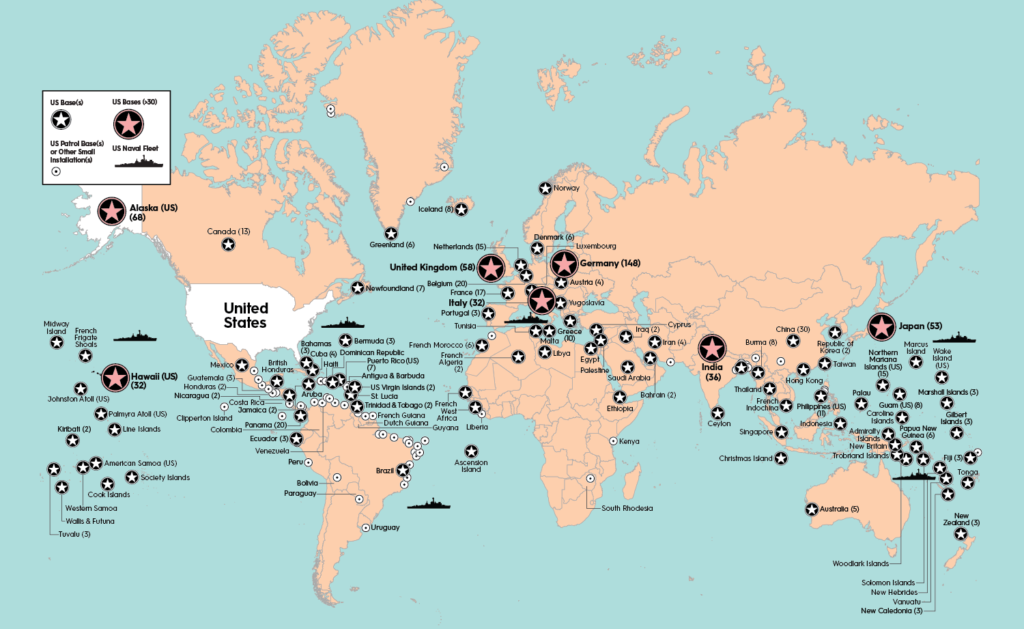
Since the creation of AFRICOM in 2007, for example, the U.S. military has obtained an outpost in Mali, drone bases in Niger, Djibouti, the Seychelles and Kenya, National Security Agency (NSA) facilities in Ethiopia, and flies drones over war-ravaged Libya and Somalia.

The U.S. military is today one of the world’s largest emitters of greenhouse gases that cause climate change, having been exempted from the 1998 Kyoto protocol and Paris climate change agreement (when the U.S. was abiding by it). There are also now at least 39,000 contaminated military sites across the U.S. and growing numbers of species threatened with extinction and people sickened by the toxic residues of American weapons systems.
In 2018, the top-five war corporations made more than $16 billion at a time when 500,000 Americans were homeless on an average every day. To sustain their obscene profits, they spend millions lobbying Capitol Hill and divvy out millions in campaign contributions to Congress. In 2012 alone, war corporations gave around $30 million and $25.5 million in 2014.
Much of this money has gone to appropriation and armed services committees, which rubber stamp gargantuan military budgets that amount to more than the total of the next ten countries combined.
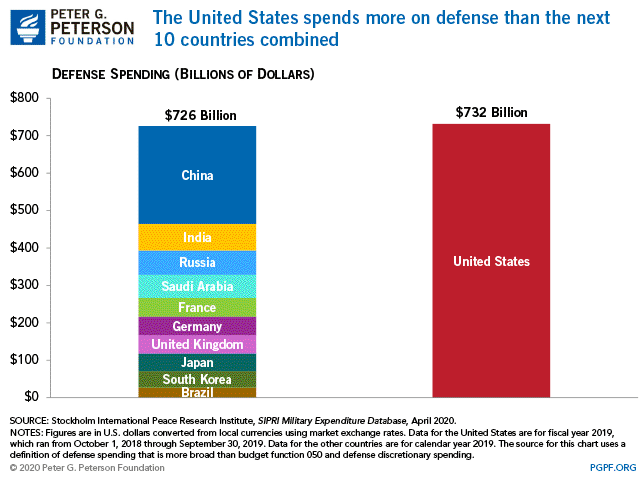
The ranking member of the Senate Armed Services Committee, Rhode Island’s Jack Reed (D), characteristically took money from General Dynamics, Raytheon, Textron, Apollo Global Management (a private equity firm heavy into war industry) and large investment banks like Merrill Lynch and Citigroup, and used his position to help Textron win a U.S. contract valued at $641 million to build 1,300 cluster bombs for Saudi Arabia.
James Inhofe, Oklahoma’s Republican climate-change denying Senator who has headed the committee under Donald Trump, has taken donations from Boeing, General Dynamics, Honeywell, Huntington-Ingalls, and Orbital TK, along with over $338,000 in the last five years from the oil and gas industry, which profits significantly from overseas military intervention and huge military budgets that Inhofe has always championed.

Besides a corrupted Congress, the military-industrial complex is sustained by the revolving door of Generals who transition from high-ranking military posts to the executive boards of defense contractors where they lobby for ever higher military budgets. James Mattis characteristically went from Commander of the U.S. Central Command to a member of the board of General Dynamics, where he swore before Congress that reduced military spending was a threat to U.S. national security, to appointment in January 2017 as Secretary of Defense, where he oversaw increases in weapons sales and the U.S. war budget. Other high-ranking officials, like former CIA Director John Brennan, have found lucrative jobs peddling new wars on television or in think tanks financed by military corporations.
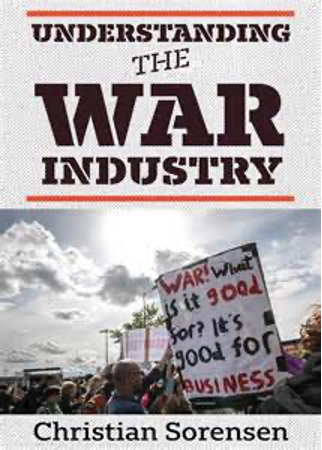
Sorensen writes that, after pumping the War on Terror for trillions in military spending, the war industry is now “returning to targeting Russia and China through ‘Great Power competition.’” This has “given the Pentagon an excuse to deploy more corporatized troops, mercenaries and goods and services right up to Russia’s borders, while Pentagon leadership has stylized such a permanent war footing as conducive to peace.”
The U.S. Executive Branch has meanwhile come to take on the function of an international arms peddler.
On any given day, the Defense Security Cooperation Agency (DSCA) manages 14,000 open foreign military sales cases with 185 countries. The latter include some of the most oppressive on the planet like Israel, which systematically oppresses the Palestinians, using weapons manufactured by Boeing, Caterpillar, General Electric, Lockheed Martin, Motorola and Northrop Grumman, and Saudi Arabia, which has used hardware from General Dynamics and Lockheed Martin to pulverize Yemen.
From May 2015 through March 2016, American war corporations sold over $30 billion worth of goods and services also to anti-democratic Gulf allies such as the United Arab Emirates, which waged the dirty war in Yemen by proxy and was known for the brutal suppression of dissenting groups. In the Southern Hemisphere, U.S. military and corporate action yielded devastating costs in countries like Honduras and Colombia, where aerial defoliation programs have poisoned the landscape and paramilitary death squads have terrorized trade union activists and supporters of the left-wing Fuerzas Armada Revolucionario de Colombia (FARC) whose principal platform is to redistribute land and wealth.

By law, the U.S. is not allowed to sell weapons to regimes that come to power through coup d’états. However, the war industry successfully lobbied the government not to recognize blatant coups, like that in Egypt in 2013 and Ukraine in 2014. The war industry at the same time does everything in its power to sustain conflicts like in the Koreas, where it profits from an endless military standoff.
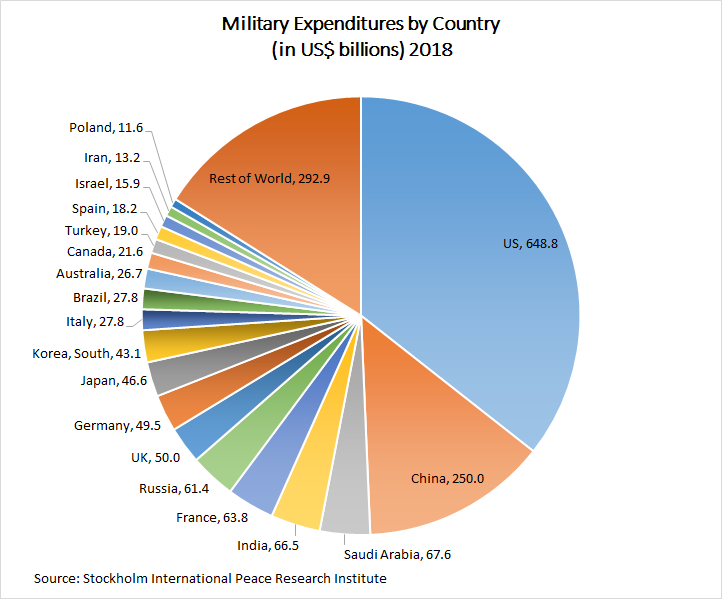
It is also in the process of provoking new ones through the Asia Pivot policy that has resulted in the military encirclement of China, promotion of NATO expansion towards Russia’s borders, and deployment of missile technology in Poland and Romania aimed directly at Russia. The inauguration of a $1.74 trillion nuclear modernization effort could ultimately lead humanity down the road to apocalypse.
One of Sorensen’s contributions is to show how the war industry sustains a progressive veneer by stressing its “green initiatives” and the diversity of its workforce.
John Brennan’s tenure as CIA Director from 2013 to 2017 was marked by his extending new opportunities for African Americans, and many CEOs are now women, like Marilyn Hewson of Lockheed Martin who was voted as “Forbes” most powerful woman in business for three years in a row. Hewson’s feminism, however, does not go very far if we consider her praise for the Saudi regime, which systematically persecutes women, or support for wars which kill women and children, and destroy families.
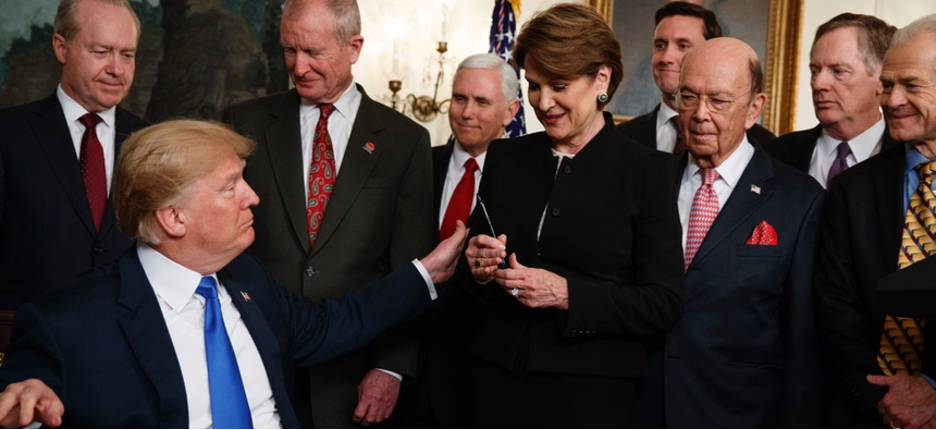
In 2018, the Pentagon—which Sorensen rightfully calls the “War Department”—failed an audit of more than 2.7 trillion dollars in assets. The accounting firms carrying out the audit concluded that the Pentagon’s financial records were “riddled with so many bookkeeping deficiencies, irregularities and errors that a reliable audit was simply impossible.”
Franklin “Chuck” Spinney, a former Pentagon employee, pointed out a pertinent accounting trick where the Pentagon routinely overestimates inflation rates for weapons systems and does not return the excess funds to the Treasury when actual inflation rates turn out to be lower. Tricks like this result in surplus slush funds which are used to fund shady covert military operations in places like sub-Saharan Africa, whose mineral wealth multi-national corporations covet.
The Puerto Rican nationalist leader Pedro Albizu Campos (1891-1965) once stated that “we live in an era of the scientific savage, where all the wisdom of science, mathematics and physics are used for the purpose of assassination.” These remarks were made before the popularization of the drone, one of the war industry’s favorite products, which has been used to kill at least 8,000 people.

What if all the geniuses who worked on these machines had applied their talents to something more useful—like new vaccines or curing cancer or carbon trapping technologies—then the world would be a far better place.
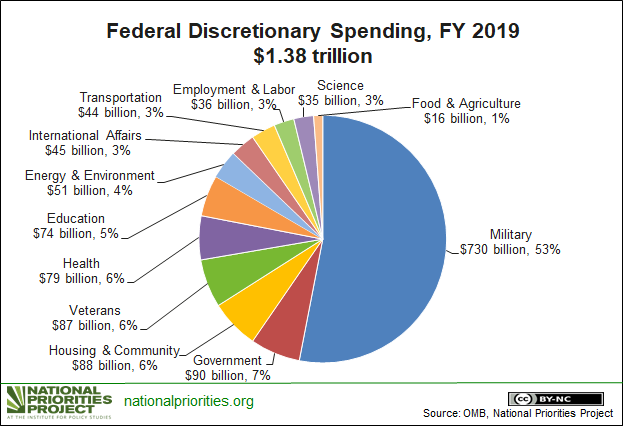
A good first step toward challenging the power of the war industry would be a program of peace education that would create a broader awareness of its harmful activities among the U.S. electorate. Unfortunately, the American educational system has been corrupted and conditions kids from a young age to go along with the status quo. During the height of the Vietnam War, student protests forced the removal of military-related research from major universities, but such research returned with a vengeance starting with the budgetary cutbacks of the 1980s and then as part of the War on Terror. Professors now compete with one another for grants that will help enhance the military’s efficiency, as genuine scientific innovation, good scholarship, and the pursuit of truth are stifled.
The subservience of the U.S. academy to war profiteers was epitomized in 2011 by the naming of a leadership institute after Lockheed Martin at Miami University of Ohio. Admiral William McRaven, who oversaw the Joint Special Operation Command (JSOC), which specialized in terrorist manhunts and assassination, was also tellingly appointed as chancellor of the University of Texas system in 2015.

The War Industry makes for a depressing read because the information presented is factually grounded and based on deep research. The one thing the author might have better emphasized is the war industry’s being rooted in the nation’s founding as a settler colonial state. The book nevertheless follows in the noble tradition of muckrakers who have exposed the bloody business of war. Whereas in the 1930s, the profiteers were derisively called “merchants of death,” today they are honored for being civic-minded and sponsor endowed chairs and departments in major universities. The peace movement clearly has a lot of work to do.

CovertAction Magazine is made possible by subscriptions, orders and donations from readers like you.
Blow the Whistle on U.S. Imperialism
Click the whistle and donate
When you donate to CovertAction Magazine, you are supporting investigative journalism. Your contributions go directly to supporting the development, production, editing, and dissemination of the Magazine.
CovertAction Magazine does not receive corporate or government sponsorship. Yet, we hold a steadfast commitment to providing compensation for writers, editorial and technical support. Your support helps facilitate this compensation as well as increase the caliber of this work.
Please make a donation by clicking on the donate logo above and enter the amount and your credit or debit card information.
CovertAction Institute, Inc. (CAI) is a 501(c)(3) non-profit organization and your gift is tax-deductible for federal income purposes. CAI’s tax-exempt ID number is 87-2461683.
We sincerely thank you for your support.
Disclaimer: The contents of this article are the sole responsibility of the author(s). CovertAction Institute, Inc. (CAI), including its Board of Directors (BD), Editorial Board (EB), Advisory Board (AB), staff, volunteers and its projects (including CovertAction Magazine) are not responsible for any inaccurate or incorrect statement in this article. This article also does not necessarily represent the views the BD, the EB, the AB, staff, volunteers, or any members of its projects.
Differing viewpoints: CAM publishes articles with differing viewpoints in an effort to nurture vibrant debate and thoughtful critical analysis. Feel free to comment on the articles in the comment section and/or send your letters to the Editors, which we will publish in the Letters column.
Copyrighted Material: This web site may contain copyrighted material the use of which has not always been specifically authorized by the copyright owner. As a not-for-profit charitable organization incorporated in the State of New York, we are making such material available in an effort to advance the understanding of humanity’s problems and hopefully to help find solutions for those problems. We believe this constitutes a ‘fair use’ of any such copyrighted material as provided for in section 107 of the US Copyright Law. You can read more about ‘fair use’ and US Copyright Law at the Legal Information Institute of Cornell Law School.
Republishing: CovertAction Magazine (CAM) grants permission to cross-post CAM articles on not-for-profit community internet sites as long as the source is acknowledged together with a hyperlink to the original CovertAction Magazine article. Also, kindly let us know at info@CovertActionMagazine.com. For publication of CAM articles in print or other forms including commercial internet sites, contact: info@CovertActionMagazine.com.
By using this site, you agree to these terms above.
About the Author

Jeremy Kuzmarov holds a Ph.D. in American history from Brandeis University and has taught at numerous colleges across the United States. He is regularly sought out as an expert on U.S. history and politics for radio and TV programs and co-hosts a radio show on New York Public Radio and on Progressive Radio News Network called “Uncontrolled Opposition.”
He is Managing Editor of CovertAction Magazine and is the author of six books on U.S. foreign policy, including Obama’s Unending Wars (Clarity Press, 2019), The Russians Are Coming, Again, with John Marciano (Monthly Review Press, 2018), Warmonger. How Clinton’s Malign Foreign Policy Launched the U.S. Trajectory From Bush II to Biden (Clarity Press, 2023); and with Dan Kovalik, Syria: Anatomy of Regime Change (Baraka Books, 2025).
Besides these books, Kuzmarov has published hundreds of articles and contributed to numerous edited volumes, including one in the prestigious Oxford History of Counterinsurgency .
He can be reached at jkuzmarov2@gmail.com and found on substack here.









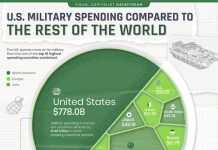

[…] In his 2020 book Understanding the War Industry (Atlanta: Clarity, 2020), Christian Sorensen emphasizes how the U.S. war industry has sustained a progressive veneer through more minority appointments and by emphasizing the diversity o…. […]
[…] In his 2020 book Understanding the War Industry (Atlanta: Clarity, 2020), Christian Sorensen emphasizes how the U.S. war industry has sustained a progressive veneer through more minority appointments and by emphasizing the diversity o…. […]
[…] media monopolies, as expanded upon in Peter Phillips’ Giants, Christian Sorensen’s Understanding the War Industry, and Michael Parenti’s Inventing Reality), has historically given these institutions great […]
[…] Another motive is to provoke destabilization so as to justify endless war—which brings huge profits to war industries that fund both major political parties. […]
[…] Christian Sorensen is an Air Force veteran and author of the new book entitled Understanding the War Industry. See CAM’s review of the book: Wars R Us: A Review of Christian Sorensen’s New Book. […]
[…] Wars R Us: A Review of Christian Sorensen’s New Book “Understanding the War Industry” […]
How Congress Maintains Endless War – System Update with Glenn Greenwald
https://www.youtube.com/watch?v=ejqYrzEX14E&feature=emb_logo
Response to this review of Understanding the War-Industry. The left & right wings, including armament & war critics, focus on research & communication such as Sorenson here, when for years, decades, centuries & 5 millennia in failed ‘EXOGENOUS’ (Latin ‘other-generated’) oligarch-run failed empire after empire. We know issues are always determined by ‘economics’ (Greek ‘oikos’ = ‘home’ + ‘namein’ = ‘care-&-nurture’) but don’t animate our own vast capable resources. As the author relates, we have a Finance-Media-Religion-Education-Military-Industrial-Legislative-Judicial-Complex & much-more, strategically organized by long standing oligarchs for their designs of command & control on the whole population of the world. The population sees us as ‘ineffectual-critics’, fulfilling our assigned colonial ‘academic-role’ using ‘exogenous’ processes to beg, protest & lobby without economic ‘action’.
People, politicians & academics discount these specialized & academic reviews because as critics we aren’t addressing or organizing their primary concerns, capacities & resources in respect of livelihood. We aren’t walking-our-talk. Each of a million ’causes’ such as MICkey mouse, competes with other ’causes’ each in their own alarm-bells-ringing ‘silo’, for popular attention. In our colonial lifestyles of economic isolation & colluding-submission to a competitive system, we aren’t economically organizing our own nor popular resources to welcome & include each other. We aren’t collectively organizing as ‘communities’ (Latin ‘com’ = ‘together’ + ‘munus’ = ‘gift-or-service’), to meet our collective needs, to stop feeding the MIC beast nor to lovingly & collectively respond together in RELATIONAL-ECONOMY. https://sites.google.com/site/indigenecommunity/relational-economy
‘INDIGENOUS’ (L ‘self-generating’) people have traditionally felt the unity of economic solidarity to respond as individuals as part of an economic whole. One of the best examples of economic solidarity as a tool for assertion of national sovereignty was India’s ‘Swadeshi’ (Hindi ‘indigenous’ aka ‘self-sufficiency’) movement. From 1917 when Mohandas Gandhi returned from South-Africa as a lawyer activist, he transformed into a Swadeshi ‘animist’ to help popularize the economic role of self-sufficiency. People were encouraged to organize their local resources, grow, food, fibre, spin thread, weave cloth, build the traditional ~100 person collective Multihome (Ashram), make salt from the sea etc. https://sites.google.com/site/indigenecommunity/relational-economy/extending-our-welcome-participatory-multi-home-cohousing
India regained pride through these examples of meeting its needs & standing together. At the height of this positive, proactive: PROCOTT, INVESTMENT & SANCTIFICATION PIS, (a giant step in effectiveness beyond BDS) India only affected some 5% of the British 5-eye (Britain, USA, Canada, Australia & New-Zealand) trade in raw-material exports from India & finished-goods imports. Yet with 15,000 kilometre shipping distances from England, & long 5 year industrial planning cycles, this 5% margin of economic leverage caused 100s of ‘5-eye’ parasitic companies to go bankrupt & the empire forced to recognize Indian ‘Swaraj’ (H. ‘Self-rule’) in 30 years of economic solidarity & mutual-aid by India’s ‘independence’ in 1947. https://sites.google.com/site/indigenecommunity/home/2-mutual-aid
All humanity’s worldwide ‘indigenous’ ancestors ‘fractally’ (‘fraction, multiplier, building-block where-the-part-contains-the-whole’) organized their societies at all levels through the ~100 PERSON MULTIHOME-DWELLING-COMPLEX (eg. Longhouse-apartment, Pueblo-townhouse & Kanata-village). Today worldwide & in the USA/Canada 70% of populations live in multihomes with the average size being 32 dwelling units or ~100 people. Isn’t it time for ‘critics’ to exemplify what we are perpetually saying by ‘acting’ to locally join-in & advocate for indigenous economic livelihood first where we live & work? Rather than continually fulfilling our ‘critic’ academic role, isn’t it time we manifest local economically inclusive, welcoming economic solidarity?
‘DO-WE-KNOW-WHO-WE-ARE-?’ neighbourhood, web-based, open-source, open-data, community-economy software as an economic project of local concertation is about bringing ‘economy’ (Greek ‘oikos’ = ‘home’ + ‘namein’ = ‘care-&-nurture’) back to its roots in the collective multihome. Why do those trying to innovate politically & economically know so little about humanity’s worldwide universal long 100s of 1000s of years of cultural-economy practice where businesses are started with minimal personal risk in our multihomes? ‘Do-we-know-?’ reflects indigenous human resource traditions, in developing software for neighbourhoods to create websites with online Human Resource Catalogues HRC, Resource-mapping & accounting in Community, Contribution, Investment & Exchange Systems CCIES. Instead of building fragmented businesses based in specialties alone, it is possible to bring people together in the indigenous traditions of multihome economies, where we can work together as friends, family, teams & communities each with complementary gifts, talents, goods & services with our primary market built in to what we do. With critical-mass economies-of-scale serving our intimate loved ones, then we scale up to larger village, city, region, national & international levels of sales for certain industrial & commercial talents, goods & services among us. Indigenous economy programs are based upon the domestic economy matrix of who we are intimately. We thereby share low-risk ‘company’ (L ‘com’ + ‘pan’ = ‘bread’) diverse enterprise development, where all succeed together through the safe economy of the multi-million-dollar (average value & earning & spending per year) multihome. This form of collective economy organization is called ‘Organizing-from-the-tree-roots’, putting people back into the driver’s seat of their homes & corporations. With women & those men who as primary organizers of domestic economy, are recognized as full partners in true economy, then we have our whole human brain back. https://sites.google.com/site/indigenecommunity/structure/9-do-we-know-who-we-are